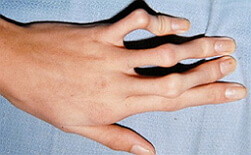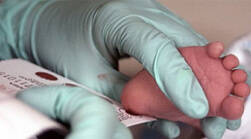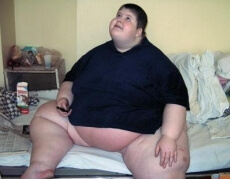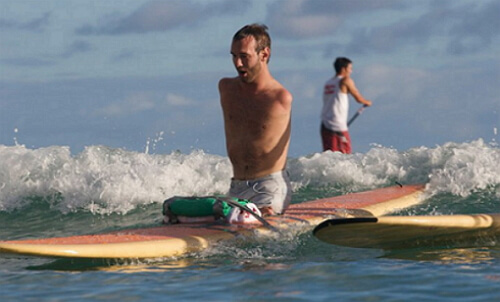Arachnodactyly
 Arachnodactyly is one of the symptoms of Marfan syndrome. Arachnodactyly was first described by the famous French pediatrician Marfan( Marfan), giving it the name dolichostenomelia, which is still called Marfan's disease. But in 1902 "arachnodactyly," as the generally accepted name proposed by Achard. This disease is considered congenital with a relatively rare pathology. There is no particular advantage in the defeat of any particular sex.
Arachnodactyly is one of the symptoms of Marfan syndrome. Arachnodactyly was first described by the famous French pediatrician Marfan( Marfan), giving it the name dolichostenomelia, which is still called Marfan's disease. But in 1902 "arachnodactyly," as the generally accepted name proposed by Achard. This disease is considered congenital with a relatively rare pathology. There is no particular advantage in the defeat of any particular sex.
Arachnodactyly is characterized by a hereditary disruption of connective tissue in the form of long, thin and curved fingers.
Arachnodactyly causes
Much of this pathology is associated with a violation of enzymes in the body that control the formation of proteins.
All the reasons for such deviations have not yet been clarified. They can arise both sporadically and be a family illness, in which all members of the same family are affected, even possibly from different generations.
Arachnodactyly is inherited by an autosomal dominant type and has a high penetrance of the mutant gene. But after three years of research by Mexican scientists in 1992, in which five siblings out of six had all the signs of the disease, they suggested that arachnodactyly can be inherited in an autosomal recessive type.
The mutant FBN 1 gene is located on the arm of the fifteenth chromosome. It encodes the formation of the fibrillin-1 glycoprotein. This gene consists of 65 exons, and this, in turn, makes it difficult to directly analyze the mutations in it. For the same reason, genotype-phenotypic correlations have not yet been proven. Therefore, gene mutations occur in the replacement of fibrillin-1 protein with arginine. This, as a rule, is the main cause of arachnodactyly.
Not the least role in the formation of vice is played by such factors that adversely affect the child during the woman's pregnancy.
Arachnodactyly Symptoms
Arachnodactyly manifests itself in a fairly strong elongation of almost all tubular bones of phalanxes of the feet and brushes, metacarpal and metatarsal bones, as well as changes in the shape of the skull and skeleton of the trunk. The hands and feet of such people become very narrow and long, which extend along the long axes, and the fingers bend in the thin joints. It really looks like a spider's paw, which gave the name to this disease( from the ancient Greek tongue arachnos is a spider).In addition to changes in the musculoskeletal system, there are also characteristic deep lesions in the cardiovascular system, as well as ophthalmic lesions of the eyes.
The pathological disease of arachnodactyly begins even in the fetal development of the fetus and is quite pronounced at the time of the birth of the child, and then in his first period of life. But, as a rule, pathology begins to intensively manifest and intensify when the development and growth of the child continues.
Arachnodactyly refers to a very serious disease that has adverse effects. Among them, there is a high overall mortality, where many children die in the first years of their life from any other disease dangerous to them. And only rare benign forms of arachnodactyly give an opportunity to live up to a more mature age.
The main symptom of arachnodactyly is muscular atrophy of a general nature with the defeat of the entire musculature. It is a good manifestation of a congenital amyotonia. When palpation of the muscles of the limbs there is a feeling of complete absence, that is, they do not stand out under the skin, and in severe cases have a consistency of mucus. Also, patients with arachnodactyly suffer from underdevelopment and / or lack of fat.
Between the elbows, knee joints and fingers of the patients, one can see translucent thin membranous membranes resembling the swimming membranes of waterfowl. As a result of poorly developed musculature and a lack of subcutaneous fat, flabbiness appears in the ligamentous apparatus, so segments of the thin long limbs are subjected to excessive passive movement.
Patients with severe arachnodactyly form can not move independently or the movement of certain muscle groups is minimized. These people are sometimes even bedridden and depend on the care of health professionals or loved ones. It is extremely difficult for them to even turn their heads in different directions.
characteristic clinical picture arachnodactyly is fatigue and weakness of a general nature, which may occur even after a meal.
For patients with arachnodactyly characterized by a large head shape, enlarged and elongated skull in length, dolichocephaly is observed. As a result of constant lying motionless on his back, the child can be seen flattened part of the occipital, frontal mounds protrude forward, extended nose and lower jaw forward so vypyachena that gives the face a kind of old, bound in a sad man.
For the arachnodactylia clinic, symptoms of abnormal eye development are important. These include - hypertelorism, subluxation of the lens, which is shifted only upwards, myopia, iridodenez. The opacity of the lens, after dislocations, further impairs vision, and leads to the fact that the patient's sight becomes motionless, and he ceases to see.
Wrongly developed ears are observed more often than ophthalmic lesions. They are characterized by a lack of cartilage, which makes them soft and flabby.
Cardio-vascular system is determined by the abnormality in the development of the heart, its muscles, valves and partitions between the chambers, leading to congenital heart disease.
Arachnodactyly affects the central nervous system, which is characterized by severe mental retardation.
No changes from the endocrine system are detected.
Thus, arachnodactyly is an innate profound change in the mesodermal system and mesenchymal dystrophy.
Although the bones are elongated and thinned, they are not subject to curvature and are not characterized by fractures of a pathological nature.
The thorax is mostly deformed and has a funnel-like appearance. Deformities can be complicated by curvature of the spine. It can be scoliosis, kyphoscoliosis, squeezed back pelvis.
arachnodactyly treatment
Currently, developed and implemented a method of pathogenetic treatment arachnodactyly that is used kollagennormalizuyuschaya therapy.
This method is based on the correction of the metabolism of various components entering the connective tissue. Even surgery on the cartilage is considered appropriate in this method of treatment. This can strengthen their regeneration.
Violations such as astigmatism, myopia are corrected using lenses or glasses.
Treatment of DVHC( funnel-shaped deformity of the chest) consists in carrying out thoracoplasty. This operation is necessary to eliminate the westernization of the anterior thorax, which leads to a decrease in the size of the thoracic cavity and insufficient expansion of the lungs.
According to indications, aortic plasty, lens extraction, tonsillectomy and adenotomy are performed.
Thus, the main treatment for arachnodactyly remains orthopedic, consisting in the correction of all deformations.
Among the medicines prescribed antioxidant and energotropic: Limontir, coenzyme, Tokferol, Riboksin, Piracetam and B vitamins
arachnodactyly Besides pharmacological treatment, the patient is prescribed physical therapy sessions where the main impact is directed to the musculoskeletal system.



